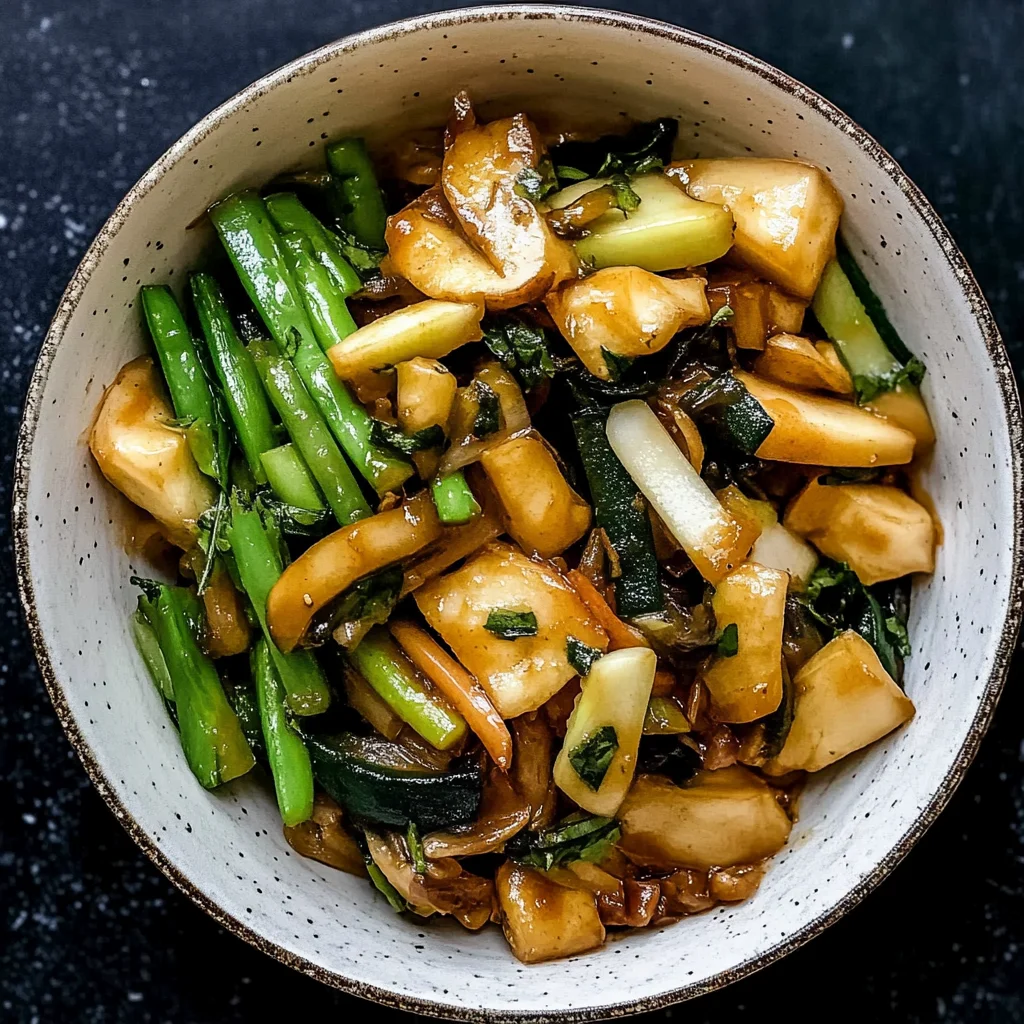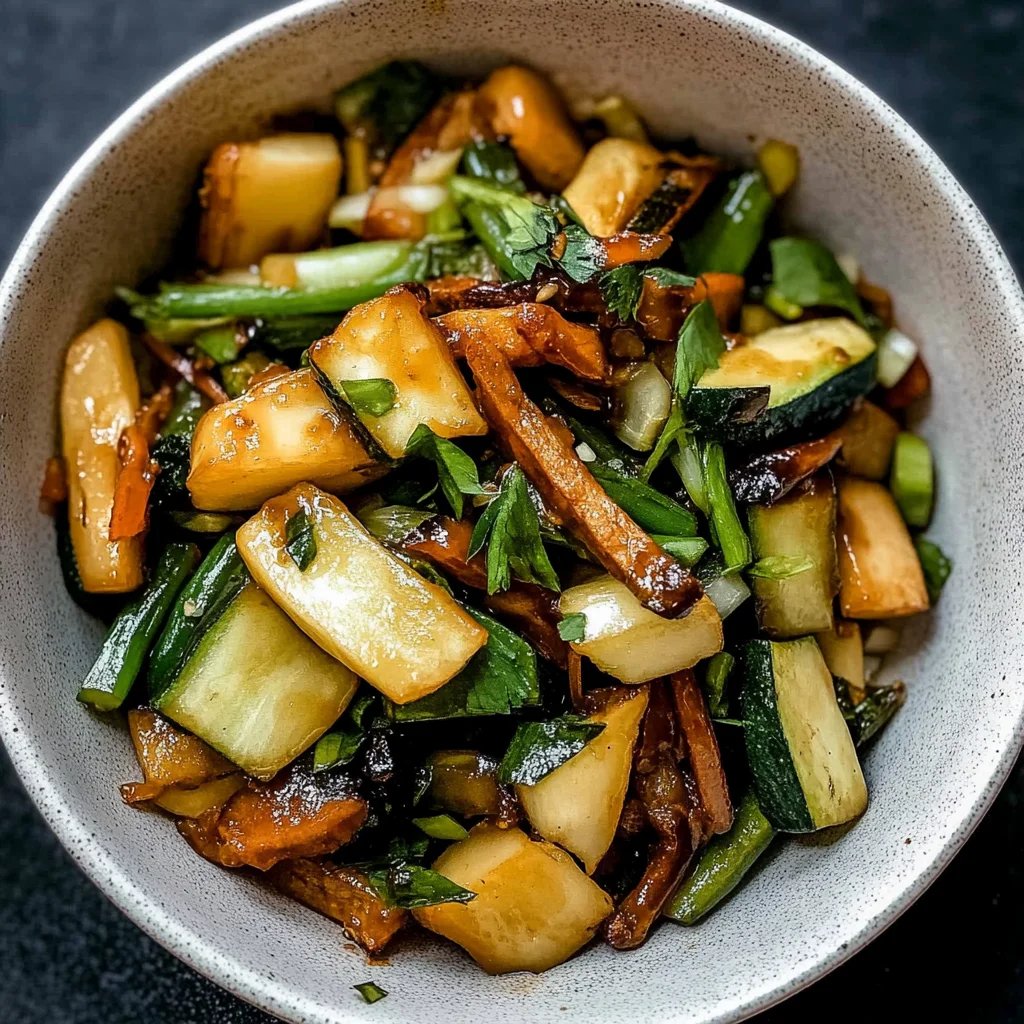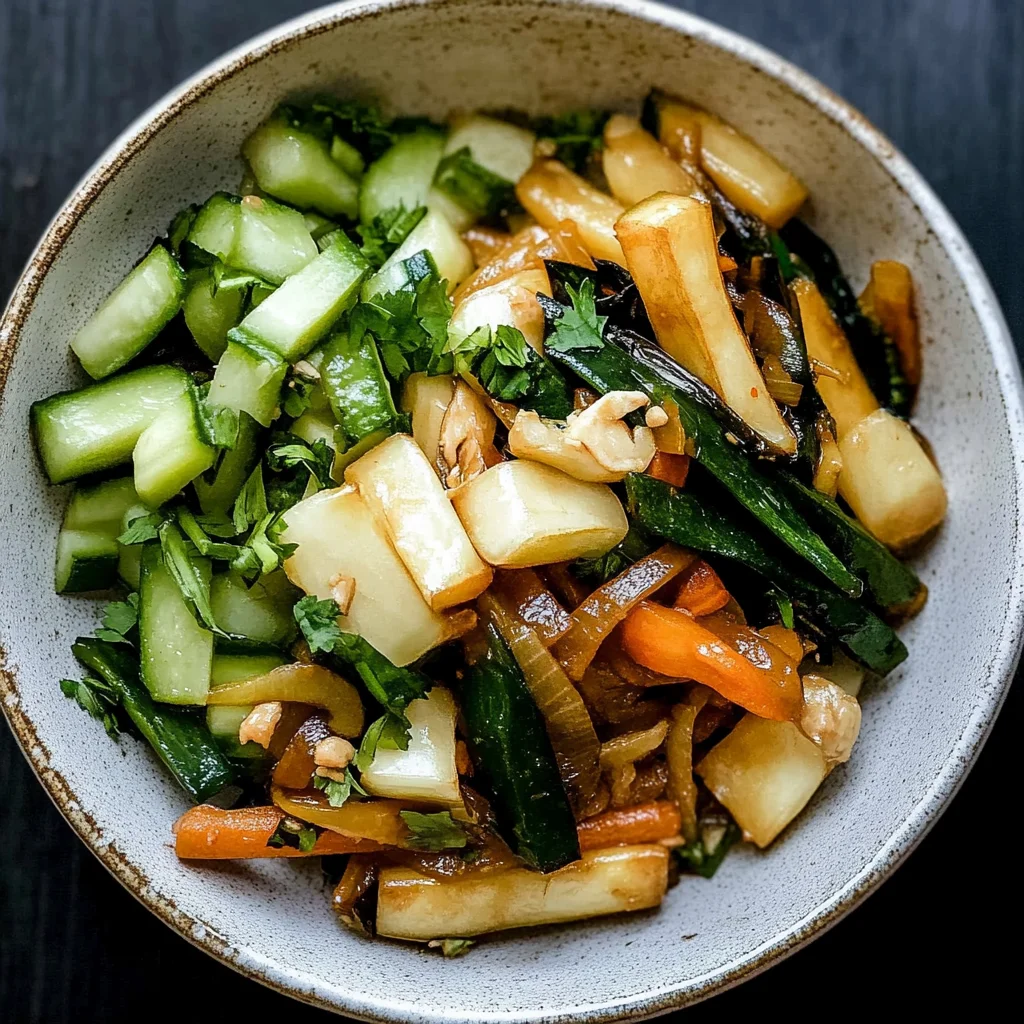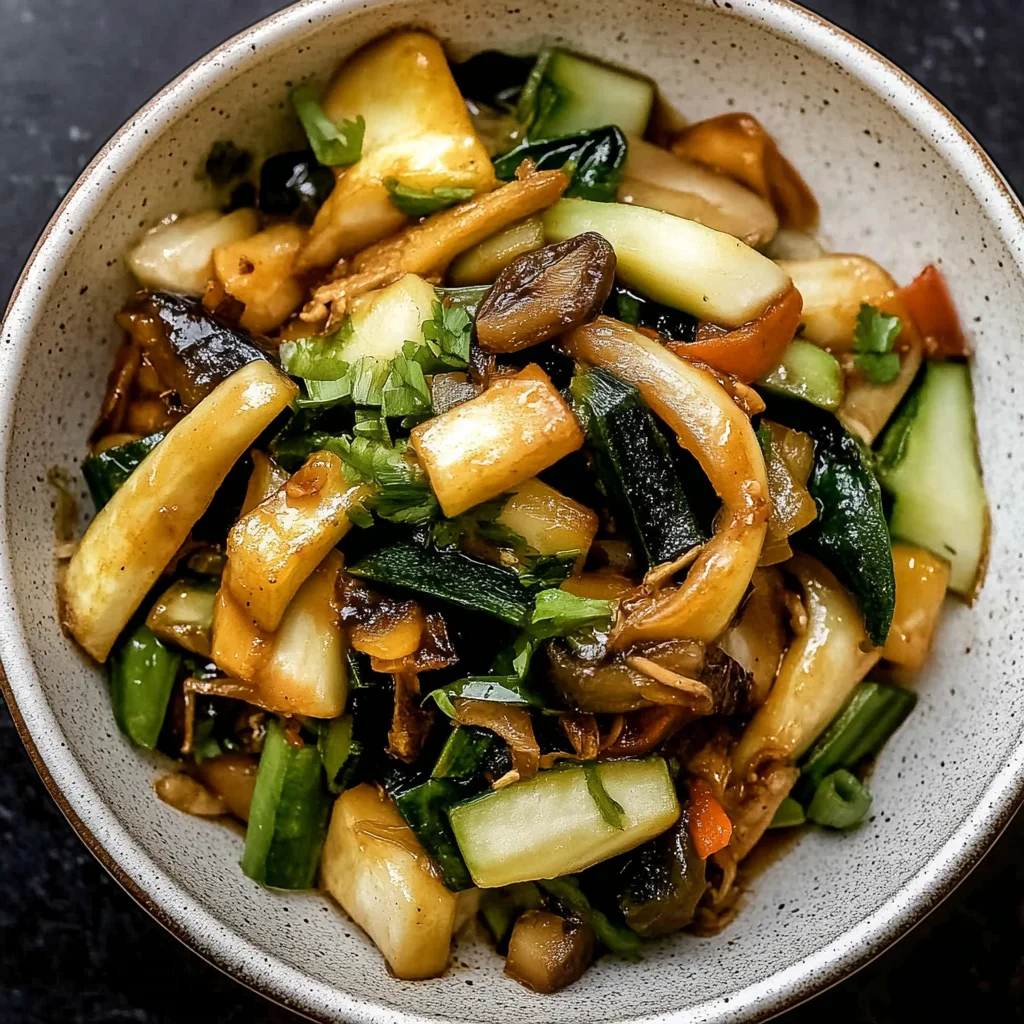Hibachi Vegetables are a delightful and vibrant dish that brings the flavors of Japanese cuisine right into your kitchen. Perfect for any occasion, this recipe highlights fresh ingredients like yellow squash, zucchini, mushrooms, and onions, creating a colorful and nutritious side dish. Whether it’s a family dinner or a gathering with friends, Hibachi Vegetables are sure to impress with their delicious taste and appealing presentation.

Jump to:
- Why You’ll Love This Recipe
- Tools and Preparation
- Essential Tools and Equipment
- Importance of Each Tool
- Ingredients
- Fresh Vegetables
- Cooking Essentials
- For Garnish
- How to Make Hibachi Vegetables
- Step 1: Heat Your Skillet
- Step 2: Sauté Onions
- Step 3: Add Remaining Vegetables
- Step 4: Season Your Dish
- Step 5: Serve Warm
- How to Serve Hibachi Vegetables
- Pair with Fried Rice
- Add Grilled Protein
- Create a Buddha Bowl
- Serve as a Topping
- Enjoy as an Appetizer
- How to Perfect Hibachi Vegetables
- Best Side Dishes for Hibachi Vegetables
- Common Mistakes to Avoid
- Storage & Reheating Instructions
- Refrigerator Storage
- Freezing Hibachi Vegetables
- Reheating Hibachi Vegetables
- Frequently Asked Questions
- What are Hibachi Vegetables?
- Can I customize my Hibachi Vegetables?
- How do I make my Hibachi Vegetables spicier?
- Can I use a different type of oil?
- Final Thoughts
- 📖 Recipe Card
Why You’ll Love This Recipe
- Quick to Prepare: In just 30 minutes, you can whip up this tasty side dish.
- Healthy Choice: Packed with fresh vegetables, this recipe is low in calories while providing essential nutrients.
- Versatile Pairing: Hibachi Vegetables complement a variety of main dishes, from grilled meats to tofu.
- Easy Cooking Method: Using just a wok or skillet makes cooking simple and convenient.
- Flavorful Ingredients: The combination of soy sauce and fresh veggies creates a savory delight that everyone will love.
Tools and Preparation
To make Hibachi Vegetables, you’ll need some basic kitchen tools to ensure everything runs smoothly. Having the right equipment will help you achieve that perfect hibachi-style finish.
Essential Tools and Equipment
- Large skillet or wok
- Cutting board
- Sharp knife
- Measuring spoons
- Spatula
Importance of Each Tool
- Large skillet or wok: Allows for even cooking and easy stirring of the vegetables.
- Sharp knife: Ensures clean cuts for all vegetables, enhancing both presentation and cooking time.
- Spatula: Perfect for tossing the veggies without damaging them during cooking.
Ingredients
Hibachi Vegetables are made with fresh yellow squash, zucchini, mushrooms, and onions. It is the same Japanese style restaurant version in the comfort of your own home.
Fresh Vegetables
- 1 cup onion, quartered and thinly sliced
- 2 cups zucchini, cut into strips
- 2 cups yellow squash, cut into strips
- 1 cup mushrooms, sliced
Cooking Essentials
- 1 tablespoon butter
- 2 tablespoons vegetable oil or olive oil
- 2 teaspoons soy sauce
- 1/4 teaspoon salt
- 1/4 teaspoon ground black pepper
For Garnish
- 2 tablespoons fresh parsley, finely chopped

How to Make Hibachi Vegetables
Step 1: Heat Your Skillet
Begin by heating the wok or large skillet over medium-high heat.
* Add the 1 tablespoon butter.
* Once it melts, pour in the 2 tablespoons oil.
Step 2: Sauté Onions
Add the 1 cup sliced onion to the skillet.
* Sauté for about 2 minutes until they begin to soften and turn translucent.
Step 3: Add Remaining Vegetables
Incorporate the prepared vegetables into the pan.
* Add in the 2 cups zucchini, 2 cups yellow squash, and 1 cup mushrooms.
Step 4: Season Your Dish
Pour in the flavor boosters!
* Add the 2 teaspoons soy sauce, 1/4 teaspoon salt, and 1/4 teaspoon ground black pepper.
Continue to cook while stirring frequently until the vegetables reach your desired tenderness (about 10 minutes).
Step 5: Serve Warm
Serve warm alongside hibachi style fried rice and yum yum sauce.
Store any leftovers in an airtight container in the refrigerator for up to 3 days.
How to Serve Hibachi Vegetables
Hibachi Vegetables are a delightful dish that can be served in various ways. This versatile recipe pairs well with different foods, enhancing your meal with vibrant flavors and textures.
Pair with Fried Rice
- Fried Rice: Serve these vegetables alongside hibachi-style fried rice for a complete meal. The rice absorbs the delicious flavors of the vegetables.
Add Grilled Protein
- Grilled Chicken or Steak: For a heartier meal, add grilled chicken or steak. The savory taste of the protein complements the fresh veggies perfectly.
Create a Buddha Bowl
- Buddha Bowl: Layer Hibachi Vegetables over brown rice or quinoa, topped with avocado and sesame seeds for a nutritious bowl packed with flavor.
Serve as a Topping
- Topping for Tacos: Use the cooked vegetables as a unique topping for tacos. Their texture and taste will surprise your guests!
Enjoy as an Appetizer
- Appetizer: Serve Hibachi Vegetables as an appetizer before the main course. They are light yet flavorful and set the tone for a great meal.
How to Perfect Hibachi Vegetables
To make sure your Hibachi Vegetables turn out just right, consider these tips. Each step will enhance their flavor and presentation.
Use Fresh Ingredients: Choose fresh vegetables for the best taste. Freshness ensures vibrant colors and nutrients.
Don’t Overcrowd the Pan: Cook in batches if needed. This allows for even cooking and prevents steaming instead of sautéing.
Adjust Cooking Time: Modify cooking time based on your preferred vegetable tenderness. Keep an eye on them to achieve your ideal texture.
Season Well: Don’t skimp on seasoning. Properly seasoning enhances the natural flavors of each vegetable.
Serve Immediately: For the best taste, serve Hibachi Vegetables right after cooking while they are still hot and crispy.

Best Side Dishes for Hibachi Vegetables
Hibachi Vegetables pair well with many side dishes that can enhance your dining experience. Here are some great options to consider.
- Hibachi Fried Rice: A classic side that complements the flavor profile of Hibachi Vegetables perfectly.
- Miso Soup: A warm bowl of miso soup adds a comforting touch to your meal.
- Edamame: Lightly salted edamame serves as a healthy snack option before or alongside your main dish.
- Gyoza Dumplings: These delicious dumplings provide another layer of flavor and texture to your dinner plate.
- Seaweed Salad: A refreshing seaweed salad adds a bit of crunch and tanginess to balance out the savory vegetables.
- Cucumber Salad: Cool and crisp, cucumber salad offers a light contrast to the warm hibachi dish.
- Sushi Rolls: Pairing sushi rolls can elevate your meal, providing variety and additional flavors.
- Tempura Veggies: Crispy tempura vegetables make for an exciting textural addition alongside your hibachi feast.
Common Mistakes to Avoid
When preparing Hibachi Vegetables, it’s easy to make a few common mistakes that can affect the dish’s flavor and texture. Here are some pitfalls to watch out for:
Skipping Fresh Ingredients: Using frozen or canned vegetables can lead to a mushy texture. Always opt for fresh produce to get that authentic hibachi taste.
Overcrowding the Pan: Adding too many vegetables at once will steam them instead of sautéing. Cook in batches to ensure they develop a nice char and retain their crunch.
Neglecting Seasoning: Forgetting to add soy sauce or other seasonings can leave your vegetables bland. Make sure to season properly during cooking for maximum flavor.
Not Prepping Ingredients: Failing to cut your vegetables beforehand can lead to uneven cooking. Always prepare and chop everything before you start cooking.
Cooking at Low Heat: Using low heat won’t give you that delicious hibachi sear. Make sure your pan is hot enough before adding the butter and oil.
Storage & Reheating Instructions
Refrigerator Storage
- Store Hibachi Vegetables in an airtight container.
- They will stay fresh for up to 3 days in the refrigerator.
- Ensure they are cooled down before placing them in the fridge.
Freezing Hibachi Vegetables
- Place cooled Hibachi Vegetables in freezer-safe bags or containers.
- They can be frozen for up to 2 months.
- Label containers with the date for easy tracking.
Reheating Hibachi Vegetables
Oven: Preheat your oven to 350°F (175°C). Spread the vegetables on a baking sheet and heat for about 10-15 minutes until warmed through.
Microwave: Place the vegetables in a microwave-safe dish, cover with a lid, and heat on high for 1-2 minutes, stirring halfway through.
Stovetop: Heat a skillet over medium heat, add a splash of oil, and sauté the vegetables for about 5 minutes until they’re heated thoroughly.

Frequently Asked Questions
Hibachi Vegetables are a popular dish, and many people have questions about them. Here are some of the most frequently asked questions:
What are Hibachi Vegetables?
Hibachi Vegetables typically include squash, zucchini, mushrooms, and onions, prepared using high heat to achieve that signature charred flavor found in Japanese hibachi restaurants.
Can I customize my Hibachi Vegetables?
Absolutely! You can add other vegetables like bell peppers, carrots, or broccoli based on your preference. Feel free to experiment with different seasonings as well!
How do I make my Hibachi Vegetables spicier?
To add some heat, consider including sliced jalapeños or a dash of crushed red pepper flakes while cooking. This will enhance the flavor profile without overpowering the dish.
Can I use a different type of oil?
Yes! While vegetable oil is commonly used, olive oil or sesame oil can also work well in your Hibachi Vegetables recipe. Each will impart its unique flavor.
Final Thoughts
Hibachi Vegetables offer a delightful combination of flavors and textures that make them an excellent side dish or even a light meal. They are versatile and easy to customize according to your preferences. Whether you serve them alongside fried rice or mix them into other dishes, these vibrant veggies make every meal special. Give this recipe a try and enjoy making it your own!
Did You Enjoy Making This Recipe? Please rate this recipe with ⭐⭐⭐⭐⭐ or leave a comment.
📖 Recipe Card
Print
Hibachi Vegetables
- Total Time: 30 minutes
- Yield: Serves 4
Description
Hibachi Vegetables are a colorful and nutritious side dish that brings the delightful flavors of Japanese cuisine to your home kitchen. This quick and healthy recipe features fresh ingredients like yellow squash, zucchini, mushrooms, and onions, expertly sautéed to create a vibrant medley that pairs beautifully with any main dish. Ideal for family dinners or gatherings with friends, Hibachi Vegetables not only impress with their appearance but also offer a savory taste that everyone will love.
Ingredients
- 1 cup onion (quartered and thinly sliced)
- 2 cups zucchini (cut into strips)
- 2 cups yellow squash (cut into strips)
- 1 cup mushrooms (sliced)
- 1 tablespoon butter
- 2 tablespoons vegetable or olive oil
- 2 teaspoons soy sauce
- 1/4 teaspoon salt
- 1/4 teaspoon ground black pepper
- Optional: Fresh parsley for garnish
Instructions
- Heat a large skillet or wok over medium-high heat. Add butter and let it melt before pouring in the oil.
- Sauté the sliced onion for about 2 minutes until softened.
- Add zucchini, yellow squash, and mushrooms to the skillet, stirring well.
- Season with soy sauce, salt, and black pepper. Cook while stirring frequently until vegetables reach your desired tenderness (approximately 10 minutes).
- Serve warm as a delightful side dish.
- Prep Time: 10 minutes
- Cook Time: 20 minutes
- Category: Side dish
- Method: Sautéing
- Cuisine: Japanese
Nutrition
- Serving Size: 1 serving
- Calories: 120
- Sugar: 4g
- Sodium: 280mg
- Fat: 8g
- Saturated Fat: 2g
- Unsaturated Fat: 6g
- Trans Fat: 0g
- Carbohydrates: 12g
- Fiber: 3g
- Protein: 3g
- Cholesterol: 10mg





